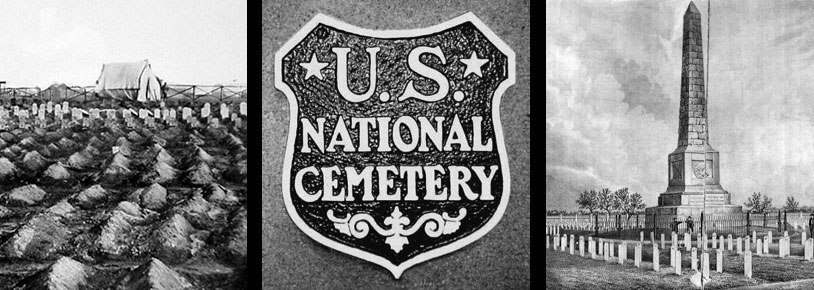

Civil War Era National Cemeteries: Honoring Those Who Served
Knoxville National Cemetery
Knoxville, Tennessee
 |
| Knoxville National Cemetery Courtesy of the Department of Veterans Affairs, National Cemetery Administration, History Program |
Eastern Tennessee was recognized as strategically important to both the Union and the Confederacy owing to its transportation linkages. Control of the area would also mean control of the railroads from Virginia to the Mississippi River. By September 1863, Union troops led by Major General Ambrose Burnside and Colonel William P. Sanders occupied Knoxville, but the Confederate army continued to press toward the city. Confederate General James Longstreet's plan was to move into Union occupied territory to set up a defensive position, hoping to draw Union troops into the open where he could begin his attack.
Confederate forces surrounded Knoxville on November 17, but Union troops held their positions, beginning a 17-day siege. On November 29, Longstreet attempted a strike at Fort Sanders, on the perimeter of Knoxville’s defenses, but a decisive Union victory drove off the Confederate advance. Longstreet continued the siege until December 4, when he withdrew his men, leaving Knoxville under Union control for the remainder of the war.
After the siege, Burnside established the cemetery, reinterring remains from around Knoxville, and other places in Tennessee, Kentucky, Virginia, and North Carolina. Captain E. B. Chamberlain designed the circular layout, and his careful, meticulous identification of the burial sites ensured that the cemetery could “be converted into a national cemetery without material alteration or change, or removal of a single body.” The cemetery initially closed to new interments in 1973. However, in 1985 the cemetery was reopened with the pathways between burial sections used for graves. These spaces were filled by 1990, and the cemetery closed permanently.
The site’s northeast property line, located on Tyson Street, features the main entrance to the cemetery with its wrought iron gates. The cemetery’s historic stone wall erected in 1875 along the northwest, southwest, and southeast boundaries remains. No superintendent’s lodge is on the cemetery grounds. The first lodge, built in 1868, was replaced in 1907 with a new lodge that was subsequently removed in 1993. A utility building from 1936 now serves as the administrative office for the cemetery. Adjacent to the national cemetery is the Old Gray Cemetery, the first Victorian-era cemetery in Knoxville designed with curving avenues and carefully landscaped grounds. The Old Gray Cemetery, named in honor of Thomas Gray, author of the famous poem, "Elegy Written in a Country Church Yard," opened in 1852, and is the final resting place for nearly 5,700 veterans, including many Confederate soldiers.
 |
Union Soldiers’ Monument Courtesy of the Department of Veterans Affairs, National Cemetery Administration, History Program |
Knoxville National Cemetery is the final resting place for two recipients of the Medal of Honor, the nation’s highest military decoration, given for “conspicuous gallantry and intrepidity at the risk of his life above and beyond the call of duty.”
Brigadier General Robert Reese Neyland, a West Point graduate who later became an ROTC instructor and football coach at the University of Tennessee, was recalled into service during World War II, becoming one of the highest ranking officers in the China-Burma-India field of operations. General Neyland and his wife are interred in Section X, Grave 16A.
One Confederate soldier, Captain George M. Coleman of the 9th Kentucky Regiment, is buried in Section D, Grave 2538.
| Plan your visit |
Knoxville National Cemetery is located at 939 Tyson St., NW in Knoxville, TN. The cemetery is open for visitation daily from sunrise to sunset. No cemetery staff is present onsite. The administrative office is located at the Chattanooga National Cemetery, and the office is open Monday to Friday from 8:00am to 4:30pm, and is closed on all Federal holidays except for Memorial Day and Veterans Day. For more information, please contact the cemetery office at 423-855-6590, or see the Department of Veterans Affairs website. While visiting, please be mindful that our national cemeteries are hallowed ground. Be respectful to all of our nation’s fallen soldiers and their families. Additional cemetery policies may be posted on site. Knoxville National Cemetery lies within the Tennessee Civil War National Heritage Area. Knoxville National Cemetery was photographed to the standards established by the National Park Service’s Historic American Landscapes Survey. |